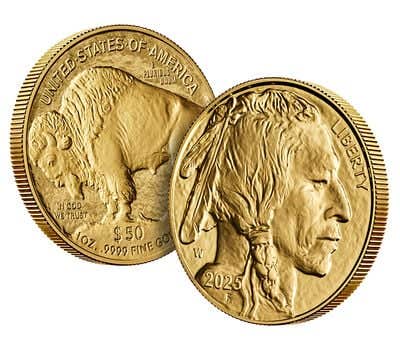Coin Clinic: Gold medals replaced by American Eagles
Why was the American Arts Gold Medallion program discontinued?
By Richard Giedroyc
Why was the American Arts Gold Medallion program discontinued?
The program had two strikes against it even before it got started. The system through which the medals were to be sold was convoluted. They were initially sold by mail order, with the purchaser being required to obtain the price by telephone based on the daily spot price of gold. The medals were later sold through a telemarketing operation. The marketing was strike one. The second strike was that they were medals competing against coins (Krugerrands and the like). The third strike came when sales figures were understandably poor. On Feb. 12, 1982, the United States Gold Commission recommended the minting of a gold coin. The gold American Eagle was the result in 1986.
I can’t find anything on the American Arts Gold Medallion program in my coin books. Can you give me a listing of what there is to collect?
Here are the medals in the program, described by obverse theme and then reverse design, followed by the number minted, and then by the number that actually were sold:
1980 Grant Wood/American Gothic (ounce) 500,000, 312,709
1980 Marian Anderson/cupped hands hold globe (half ounce) 1,000,000, 281,624
1981 Mark Twain/steamboat (ounce) 141,000, 116,371
1981 Willa Cather/woman operating a field (half ounce) 200,000 , 97,331
1982 Louis Armstrong/trumpet and musical notes (ounce) 420,000, 409,098
1982 Frank Lloyd Wright/landscape and building (half ounce) 360,000, 348,305
1983 Robert Frost/inscription (ounce) 500,000, 390,669
1983 Alexander Calder/mobile (ounce) 410,000, 75,571
1984 Helen Hayes/comedy and drama masks (ounce) 35,000, 33,546
1984 John Steinbeck/farm (half ounce) 35,000, 32,572
n Do mintage figures and rarity impact the value of the American Arts medals?
There does not appear to be an active market in buying and selling these medals except as bullion. The only attempt to sell them to collectors appears to be when the medal is slabbed in some high Mint State grade. For this reason at the time this is being written it does not appear anyone is buying or selling them priced on availability.
Are there any statistics for the survival rate of American Arts Medals?
Many of the American Arts medals have been scrapped for their gold, however there is no source that gives a true picture of how many have survived. From my own experience as a coin dealer I purchased a significant number of them through about 2007, but have seldom encountered them since.
Are there other U.S. Mint products that are not listed in what I would call mainstream coin books?
There are many. The U.S. Mint has been striking medals for both military and civilian use almost since it commenced operations. The Mint has on occasion struck coins for other countries as well, many of these coins carrying the appropriate mintmark. There are specialized numismatic books in which some of these are listed, but I am unaware of an all-encompassing publication listing everything other than U.S .coins that the U.S. Mint has produced.
Some unexpected individuals are depicted on the gold American Arts medals. Who selected what designs would appear on these medals?
Iowa Representative Jim Leach made the suggestion that the medals “honor 10 individuals who have been distinguished contributors to the arts – music, painting, writing, architecture and the theater. Other fields might well be chosen, or other people than I have selected within the field of arts, but the point I want to emphasize is this: while our coinage is and should be devoted to honoring those who have contributed to our political heritage, medals offer us an opportunity to honor those who have contributed to our cultural development, our economic achievements, our technological expertise, and other accomplishments which reflect the wide dimensions of our democratic society.” Leach’s suggestion was in the Gold Medallion Act signed by President Jimmy Carter on Nov. 10, 1978.
What is the purity of the gold in the American Arts medals?
The medals were struck of .900 fine gold, with the actual gold weight being either 0.5 troy ounces or 1.0 troy ounces as was appropriate to each issue. There were no proofs, only uncirculated strikes.
I have seen “silver wash” referred to as “vermeil” or “gilt.” Is that correct?
Neither term would be correct for silver wash, which is a term describing a (usually base metal) piece that has a very thin coating or plating of silver. The wash refers to the process, since the silver is deposited from a solution. Vermeil is silver that is plated with gold, and gilt or gilded can be either gold plated or plated with some other substance that looks like gold. The brass alloy (95-percent copper and 5-percent zinc) used for the U.S. cent (1963-1982) is called “gilding metal.” Coins that have received a deposit of copper alloy from the annealing process are frequently mislabeled as having a copper “wash.”
Are there two varieties of the design of the $3 gold piece?
The coins of the first year of production, 1854, from all three mints have the word DOLLARS in small letters on the reverse. The rest of the production 1855-1889 has the word in large letters.
When and where was the Lewis & Clark Exposition held?
It was held in Portland, Ore., from June 1 to Oct. 14, 1905, to honor Meriweather Lewis and William Clark, Louisiana Territory explorers in 1805.
E-mail inquiries only. Do not send letters in the mail. Send to Giedroyc@Bright.net. Because of space limitations, we are unable to publish all questions.
More Coin Collecting Resources:
• Order your 2013 Yellow-Bellied Sea Snake Coin Settoday!
• IT’S HERE! Order the 2014 North American Coins & Prices.
• Get the 2012 Coin of the Year – limited quantities remain!
• See what guides and supplies our editors recommend for keeping up with your collection.









